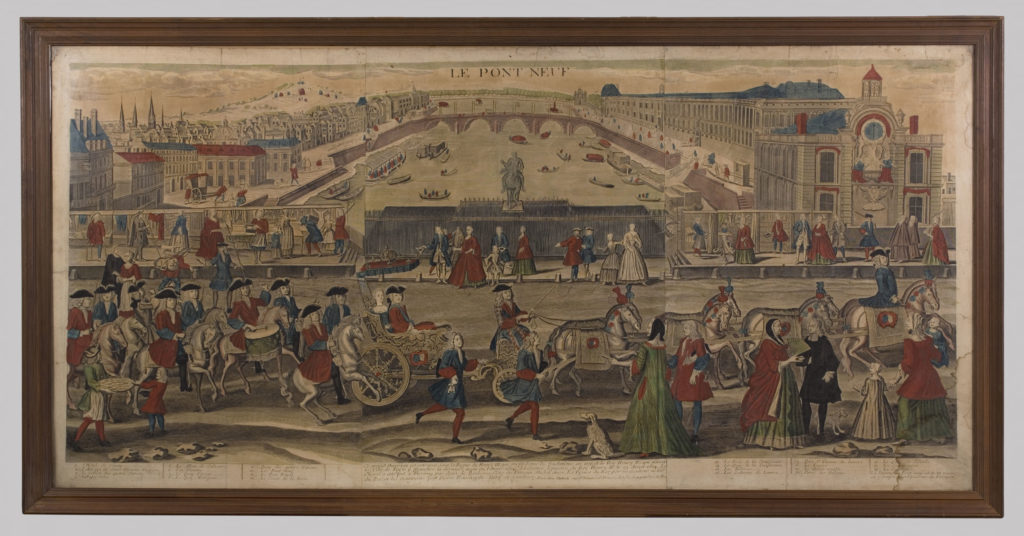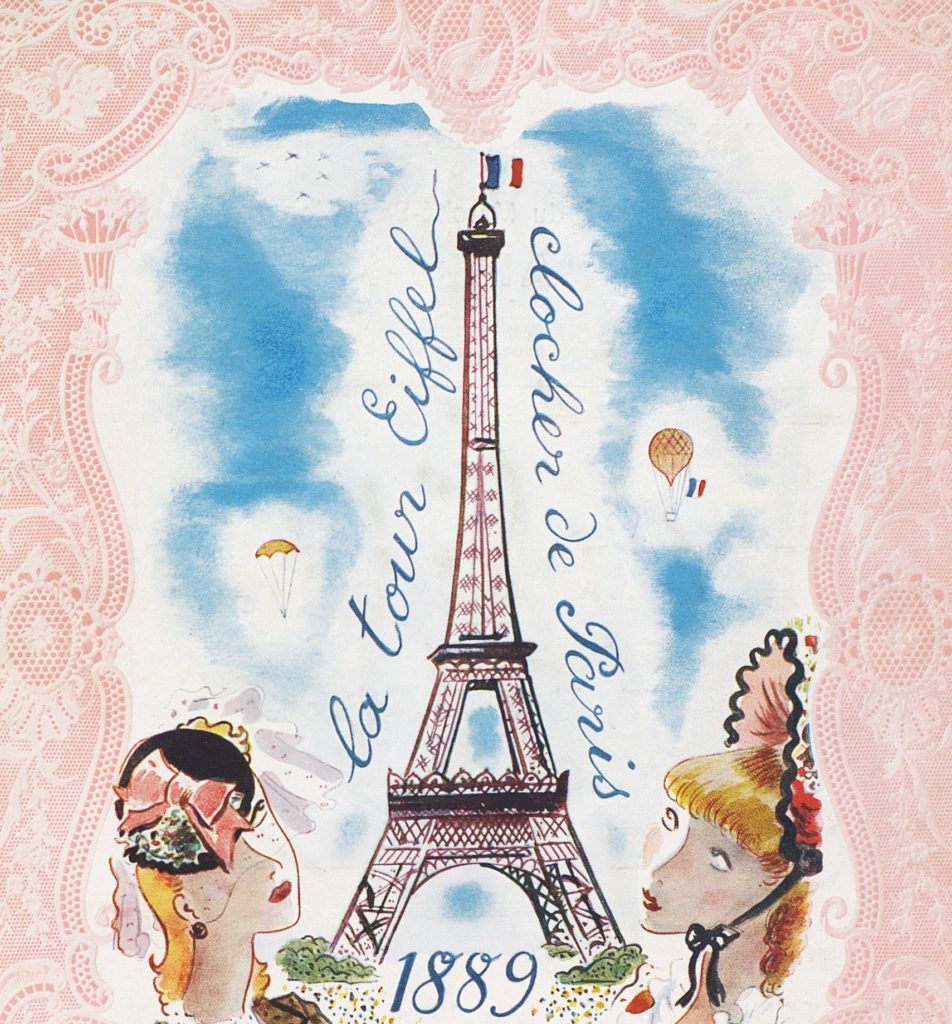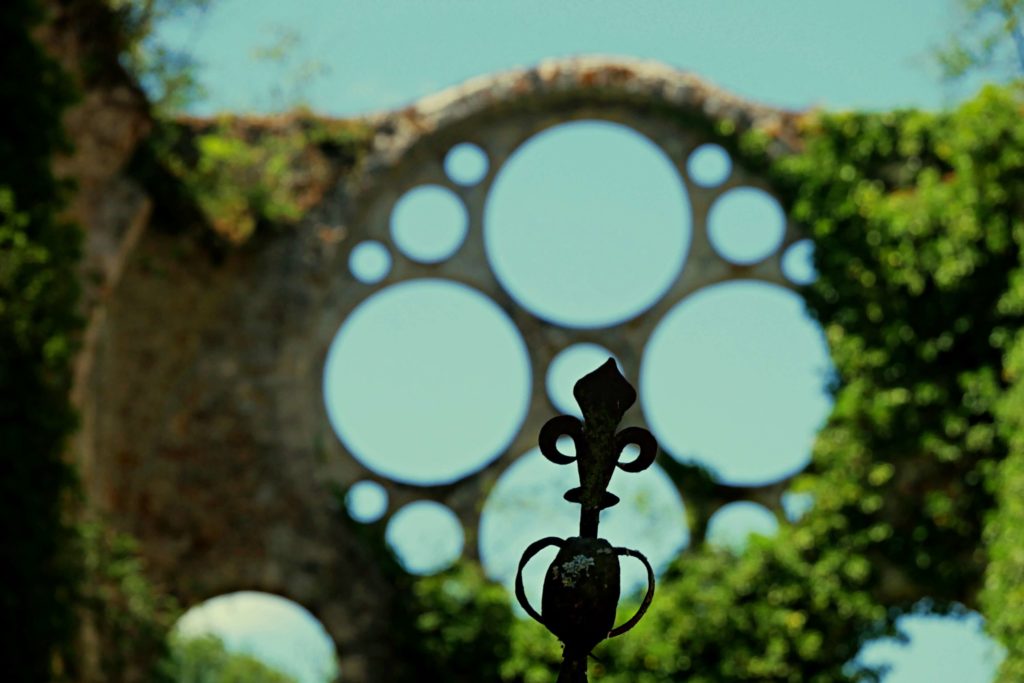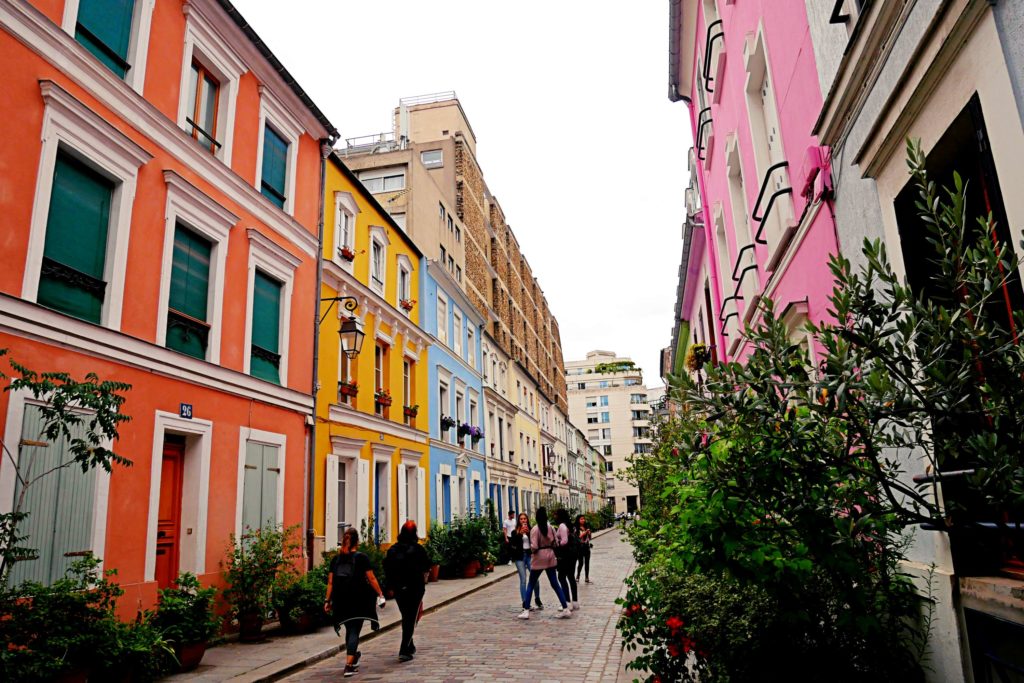Welcome to Paris everyone. It’s a lovely, sunny day here in the 17th century, just ignore the ever present rumblings of war. I do hope you’re all wearing comfortable shoes, we’ve a lot to see today! Any first time visitors to Paris? All of you? Great to hear, you are going to have a wonderful day. Here are your maps, feel free to draw pictures of the sights as we go along.

porte de Saint-Denis
So we begin our tour here at the gate of Saint Denis, one of the many gates to be found on the city walls surrounding Paris. You may have noticed that King Louis XIV has started to pull some of these walls down as the city is becoming a little too crowded for his liking, and he is putting in lovely tree-lined boulevards in their place.

This beautiful arc de triomphe was built in 1672 in place of a much earlier, medieval gateway. It’s traditionally been where the kings and queens of France have entered into Paris. If we’re lucky, we might get to see….. Oh look at that, Louis XIV and his queen consort Anne of Austria have just driven through the gate in their carriage. Can everyone see? I know it’s a bit difficult with all the crowds.

Les Halles
So let’s move on. We are going to make our way to the south, towards the Seine river, following rue Saint Denis. If you turn to your right, you will see the markets of les Halles. There have been markets here since the time of Louis the Fat in the eleventh century, but the ones you see here today were rebuilt in 1550. You can come back here a little later for your fish or bread or wine.

We will follow the rue Saint Denis all the way to the Seine. If we’d been here a couple of centuries ago during a procession of the monarchs, there would have been silks and tapestries hung from all the buildings, the air would have been perfumed with scented water (much better than the usual smell of horse manure), orchestras played music and pop up theatres performed biblical scenes. As a special treat wine and milk would be flowing from the many fountains!
Île Louviers
Let’s just take a stop here and look at the view to the east of the Seine river. The small island in front of you is the third natural island of the Seine called Île Louviers. It’s uninhabited and right now used only for for its wood. Perhaps one day it will be joined to the right bank and won’t be an island any more!

Notre Dame Cathedral
Moving on to the Île Notre Dame, where we will find, wait for it, the Cathedral of Notre Dame. This famous cathedral was constructed in the 12th century and much has been added over the last 500 years. This is where the divine church services for royalty and very important people are held. If you want to get into the good books of the king or of God himself, this is place to give your offerings; inside you will find many priceless paintings, tapestries, statues, gold and silver works. Just don’t be like a thief in the year 1218 who hid himself in the vaulted ceiling and tried to lift the silver vessels and candlesticks from the altar below: the candles were still lit and he set fire to the rich draperies! Needless to say he was not successful.

Should you become ill on your trip to Paris, just next door to Notre Dame, on the right, is the Hôtel-Dieu de Paris. Let’s walk around to see the back entrance. This is the oldest hospital in Paris, and also known for its charitable works.

It’s been a long morning, and the best is yet to come! Let’s pop into this patisserie and grab a few things for a quick lunch. Let’s see what’s on the menu…. Rabbit, Hare, Leg of Ham, Galette, Pie; so difficult to choose!

Place Dauphine
Next stop on our walking tour is the Place Dauphine, at the opposite end of the Île Notre Dame. There is some conjecture that one day this island will be known as Île de la Cité! Place Dauphine was constructed in 1608 for the birth of the dauphin, that is, the person next in line to be the king of France. In this case it was the future Louis XIII. In 1660 a sumptuous arch of more than thirty metres high and an ampitheatre were added to celebrate the marriage of Louis XIV and his bride, Maria Theresa of Austria.

Pont Neuf
If you look through the arch, you will see we are almost at the Pont Neuf. With a lot of pomp and ceremony, the first stone for this bridge was laid in 1578 by Henri III. The stone contained silver and copper gilt, effigies of the King and his wife Louise of Lorraine, and Catherine de Médicis his mother. However, civil war delayed the progress of the bridge and it was completed by Henri IV. You can see the statue of Henri IV on his horse holding pride of place there. The Pont Neuf is an important highway between the right and left banks of the Seine river, and as it’s so well built, perhaps one day it will be the oldest bridge in all of Paris.

Louvre and the Tuileries Palace
Looking to your right, quite impossible to miss, are the highlights of our tour. The Louvre and the Tuileries Palace.
We first heard of the Louvre in the 7th century when King Dagobert kept his horses there, though I’d imagine it was slightly less grand then. In 1204 King Phillip Auguste converted it into a citadel surrounded by wide ditches and flanked by high towers, with a central tower accessible by drawbridge. In 1546 it was converted into the primary residence of the French kings. You can see to your right the galleries of the Louvre; in the middle is the Tour de Coin (Corner Tower) which was a part of the walls which previously existed here to prevent attacks from the river. On the opposite side, on the left bank of the Seine, is the Tour de Nesle which is there for the same reason. Louis XIV will very soon begin work on a new facade for the galleries along the river, which is expected to be a spectacular example of French classicism.

I am excited to finally reach our final destination! The Tuileries Palace is considered one of the finest palaces in the world. For many years the area was called la Sablonnière, or the sandpits. In 1416, Charles I referred to it as the Tuileries because it was where the tuiles (tiles) were made. Francis I bought the palace in the 16th century for his mother Louise de Savoie because she preferred the air on the right side of the Seine river, and it later became yet another richly decorated residence for the French monarchy. You can see before you the stunning gardens recently designed by the celebrated Lenôtre, which are open to the public.

So we come to the end of our seventeenth century walking tour of Paris. I hope your feet are not too sore and you have enjoyed the day! If you have any questions or feedback on your experience, feel free to use the comment section below.
Useful links
If you’d like to further explore the places we visited today, here are some links to follow:
https://www.carnavalet.paris.fr/ Carnavalet Museum, most of the images above were taken from the museum (not literally!)
https://en.parisinfo.com/ Official site for visitors to Paris, it has loads of information on all the places mentioned above.
https://www.louvre.fr/en Official Louvre website. You can have a virtual visit of the museum from your couch!
https://www.notredamedeparis.fr/en/ Website of Notre Dame cathedral
Hope to see you on the next tour! Au revoir.




It’s amazing that no matter what century you tour Paris in nothing really changes. Apart from modern shops and a few more people and of course fashion, some of the landmarks are centuries old.
It makes Paris that extra bit special!